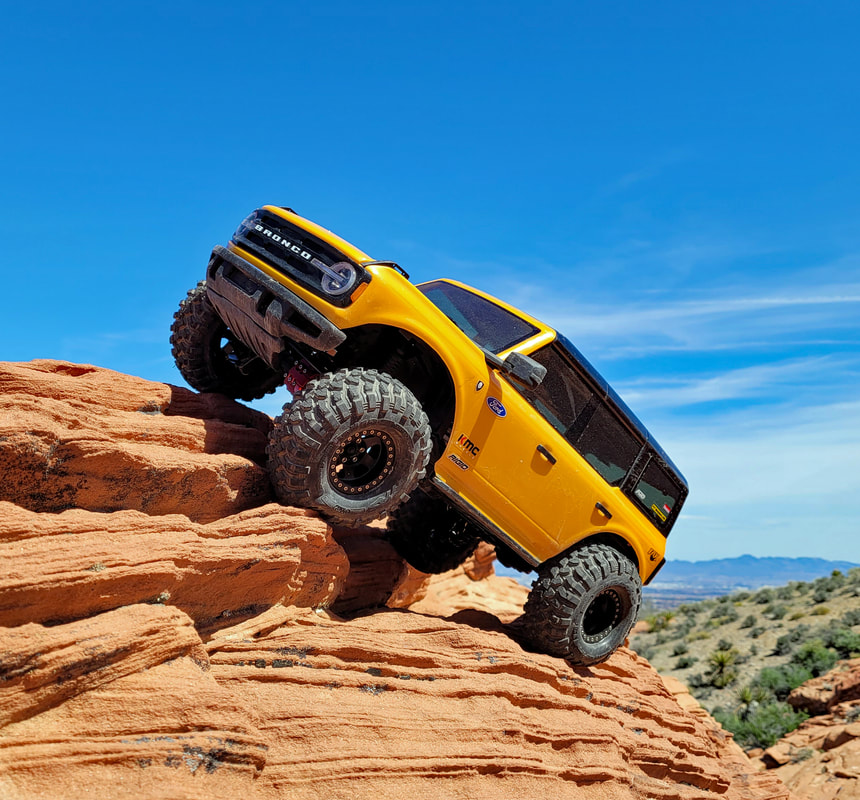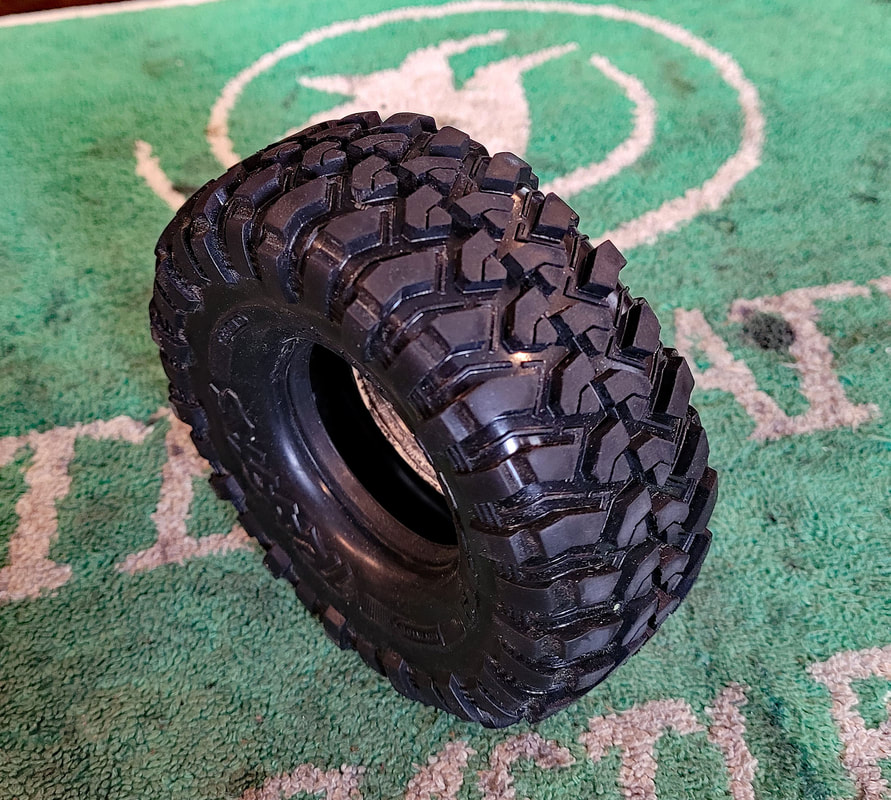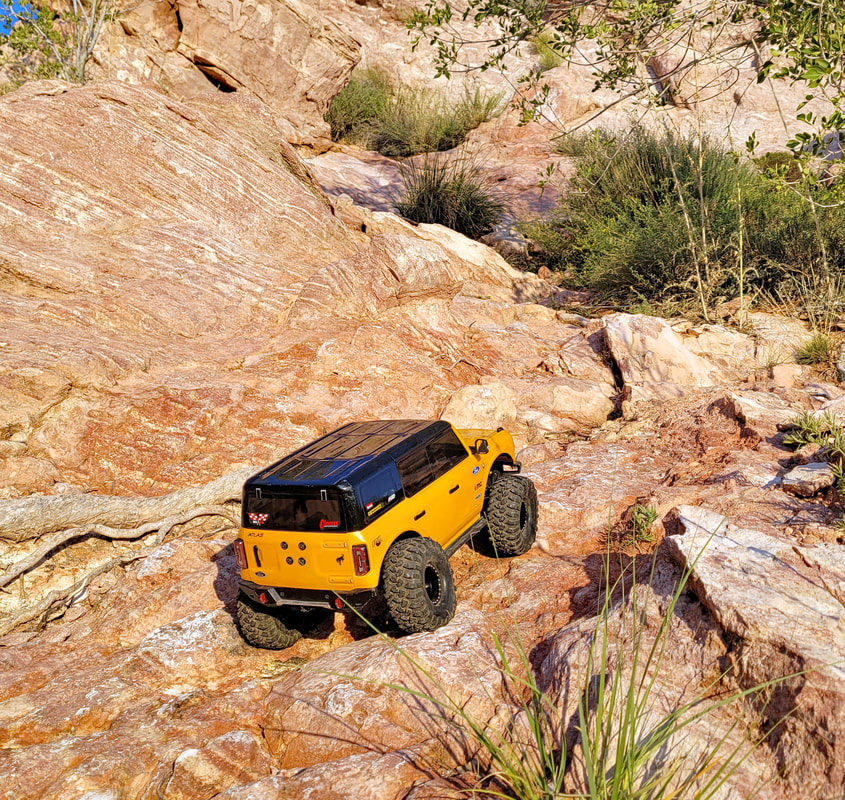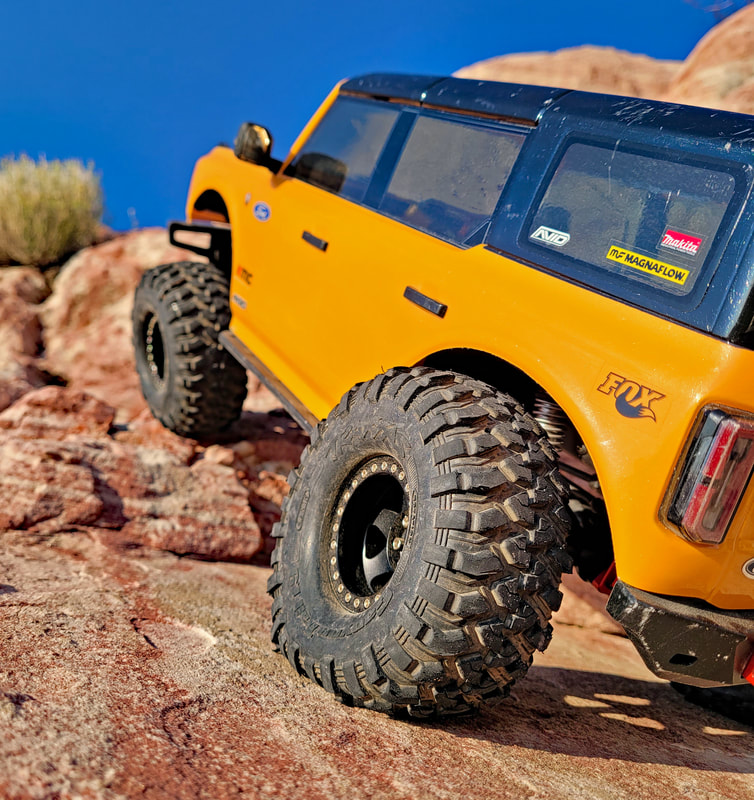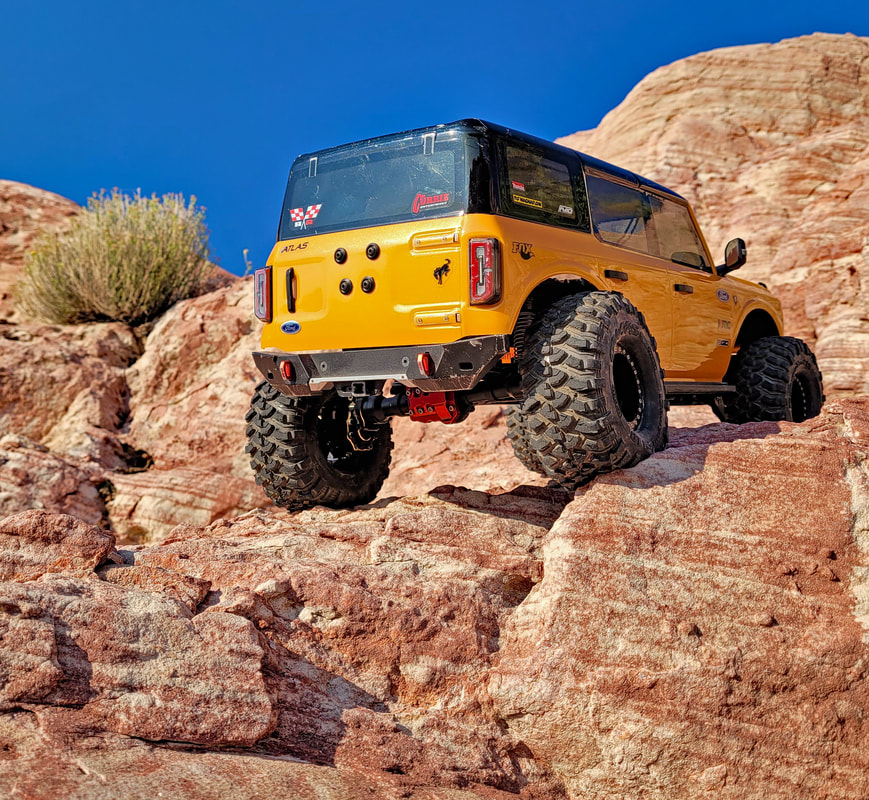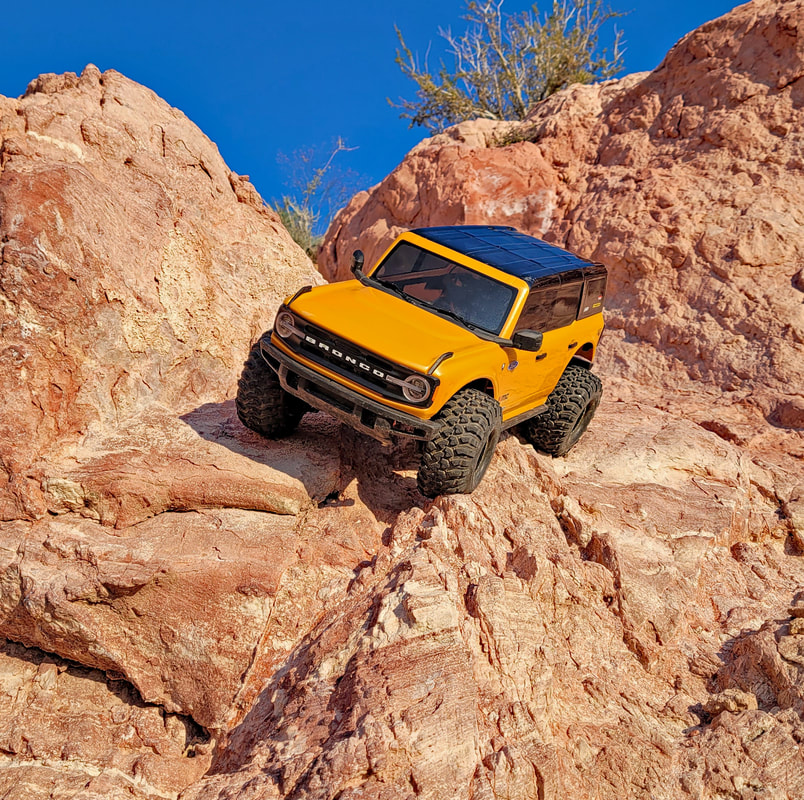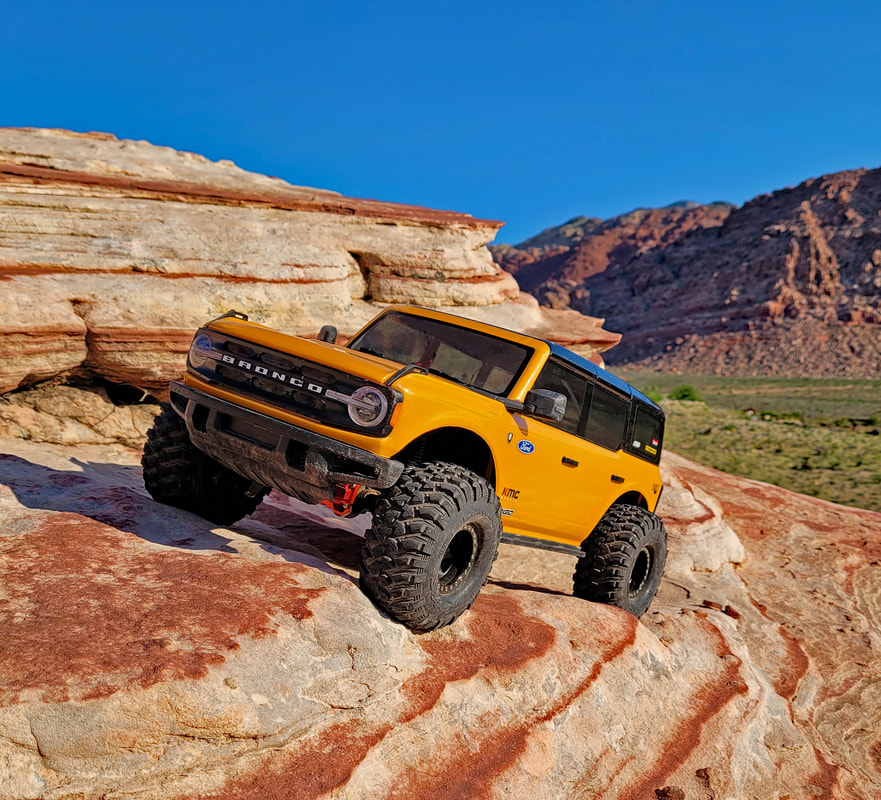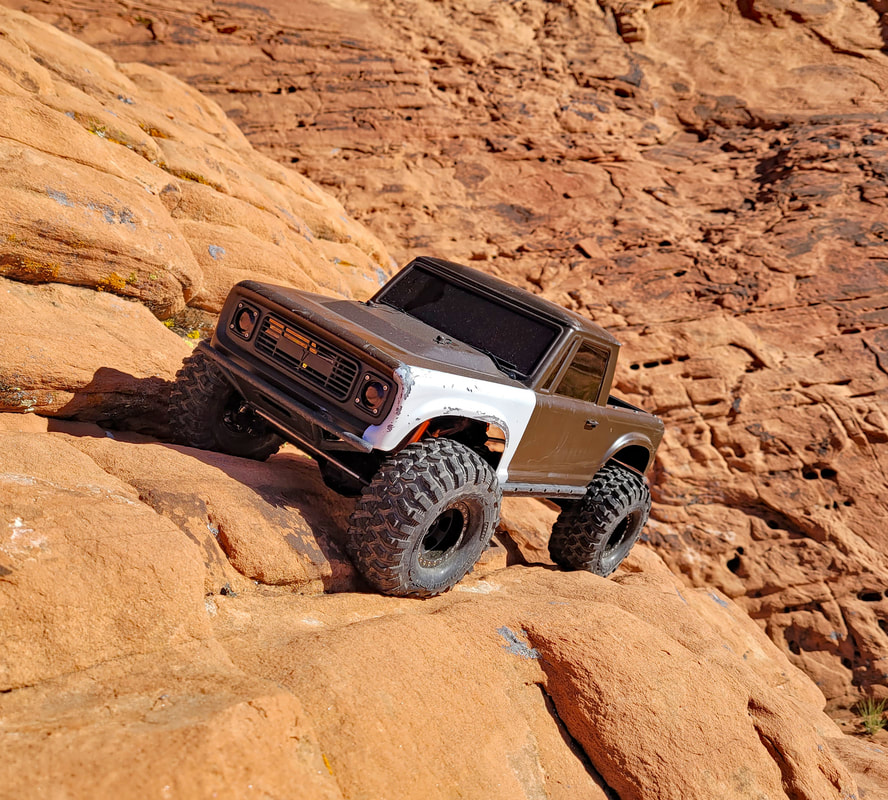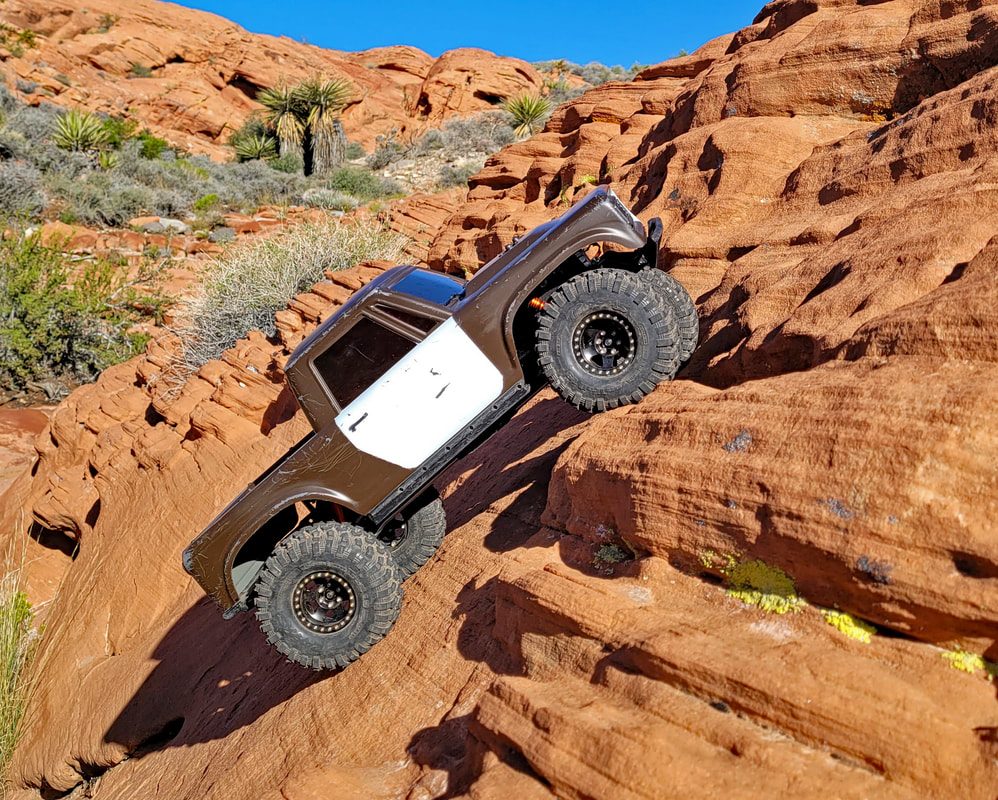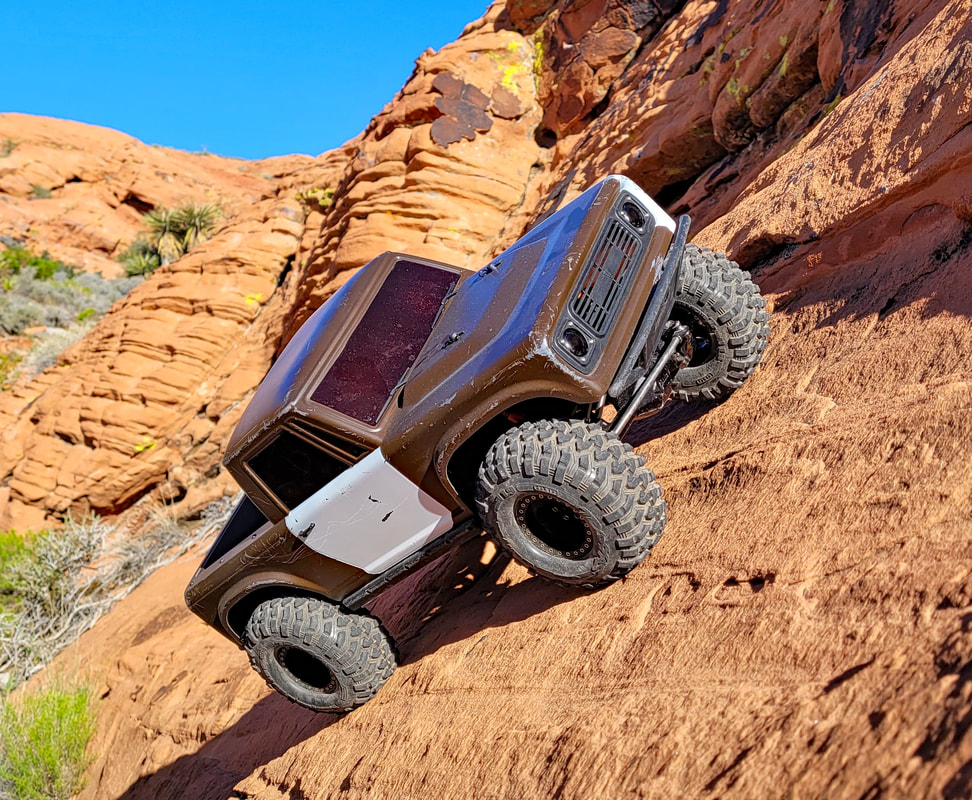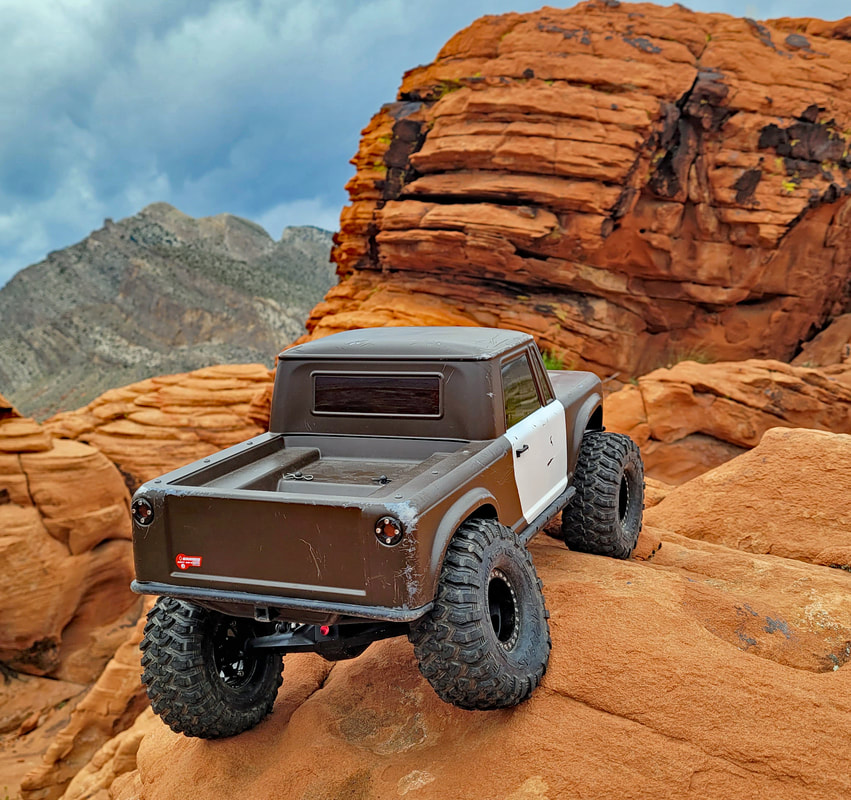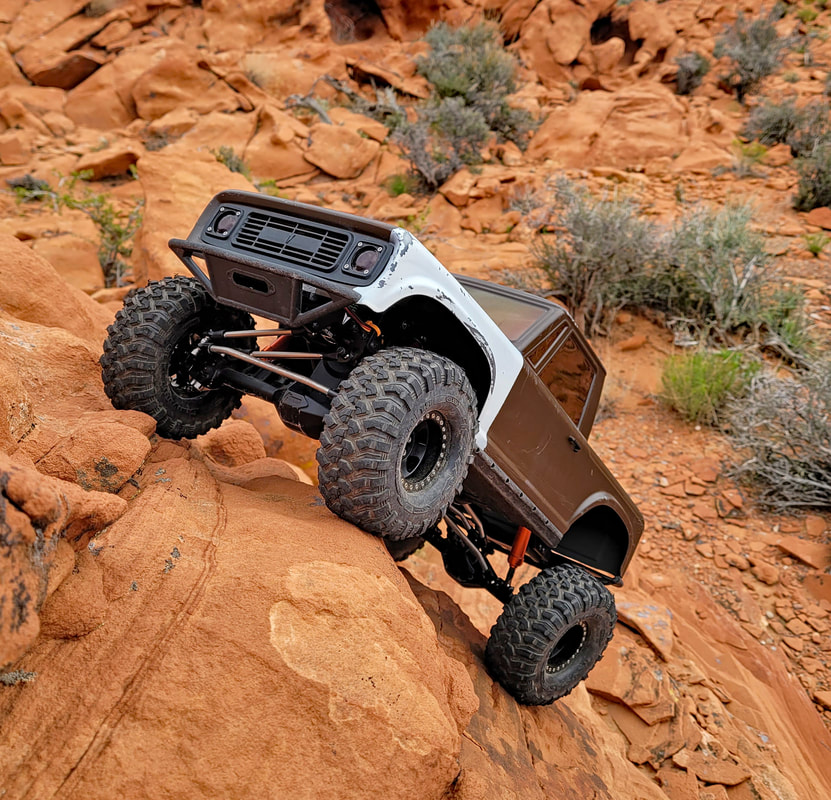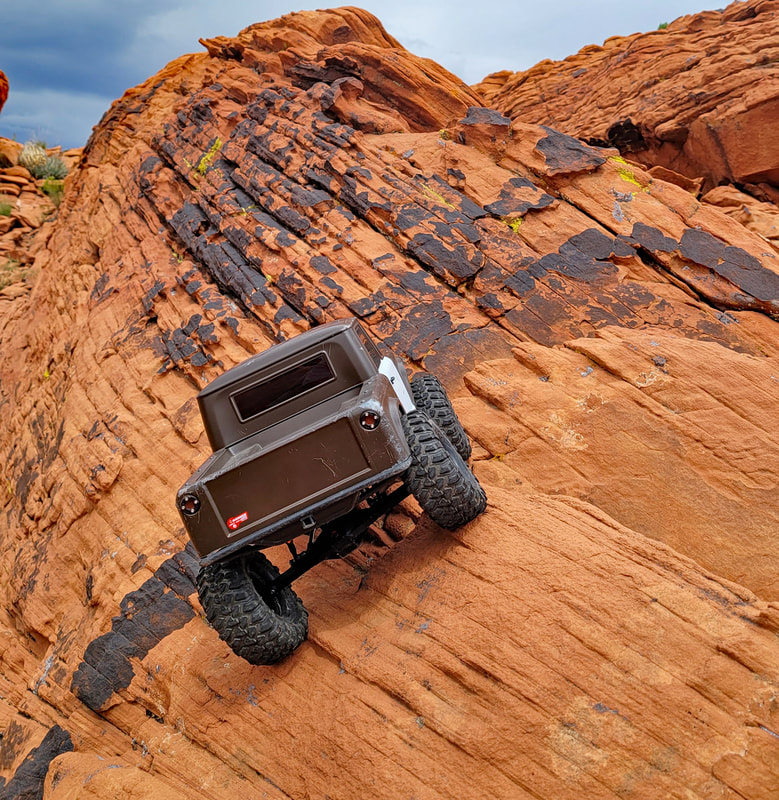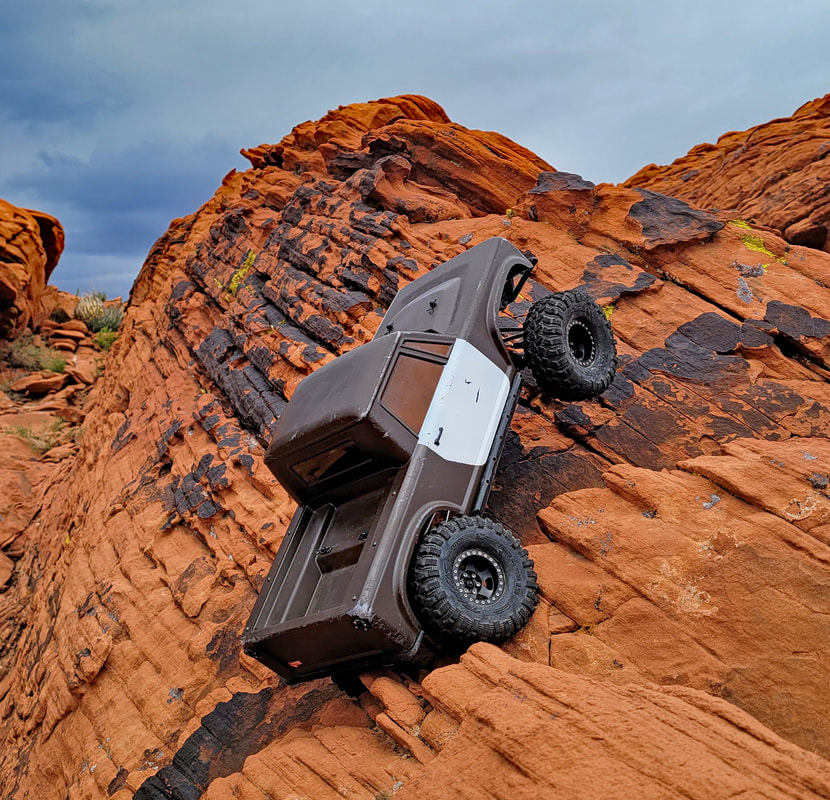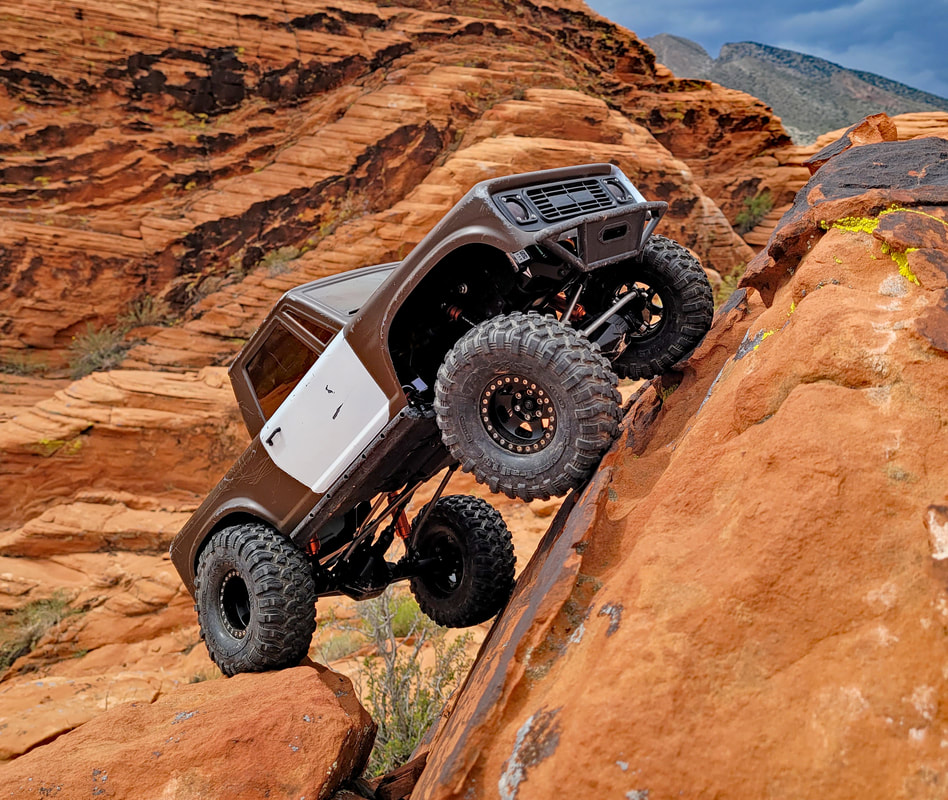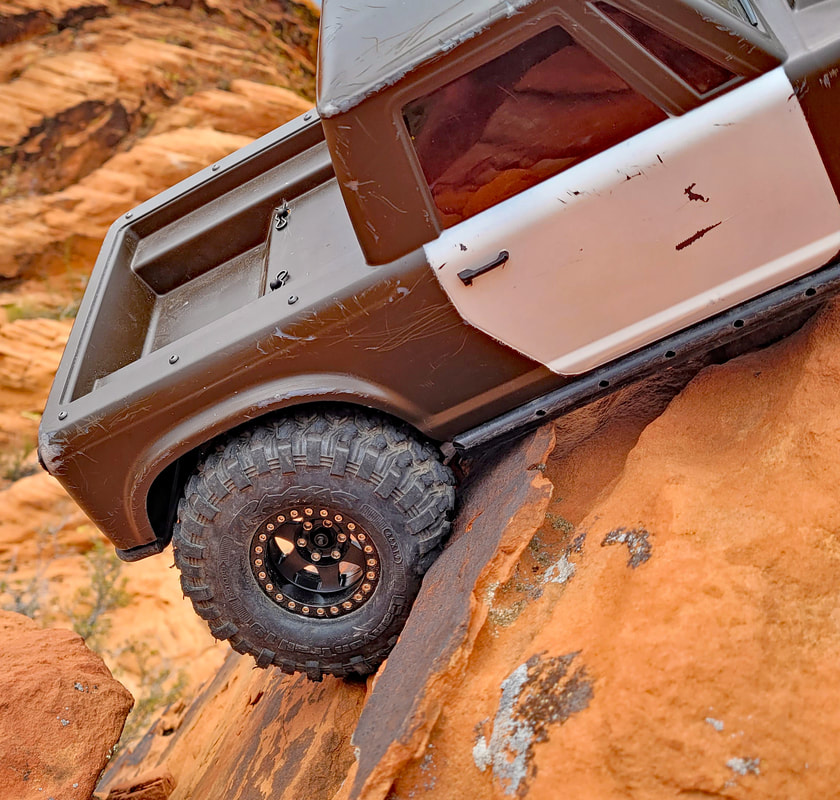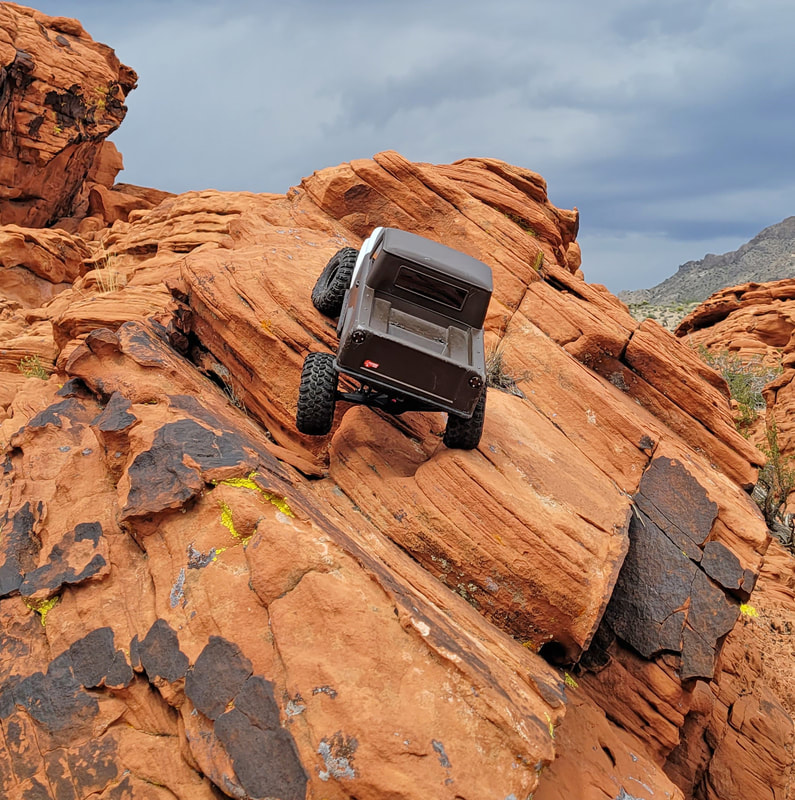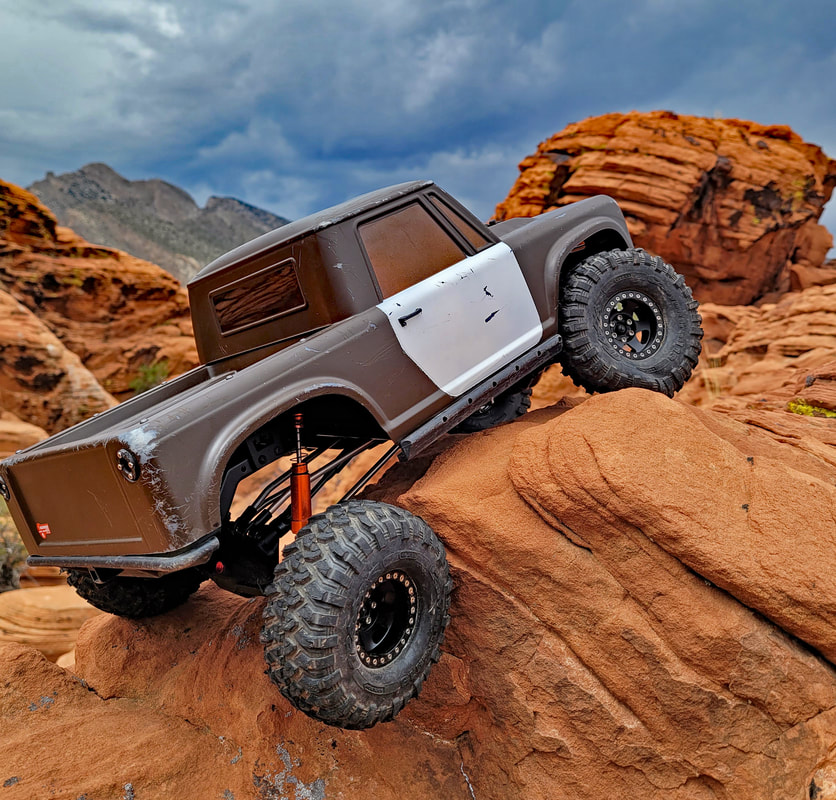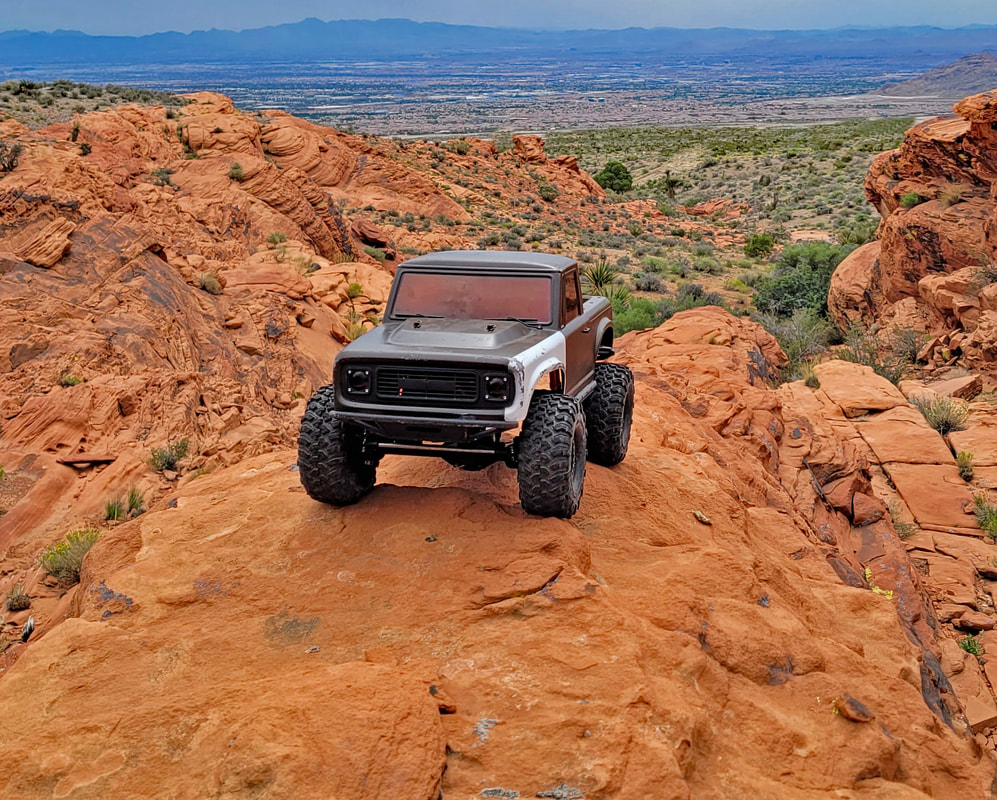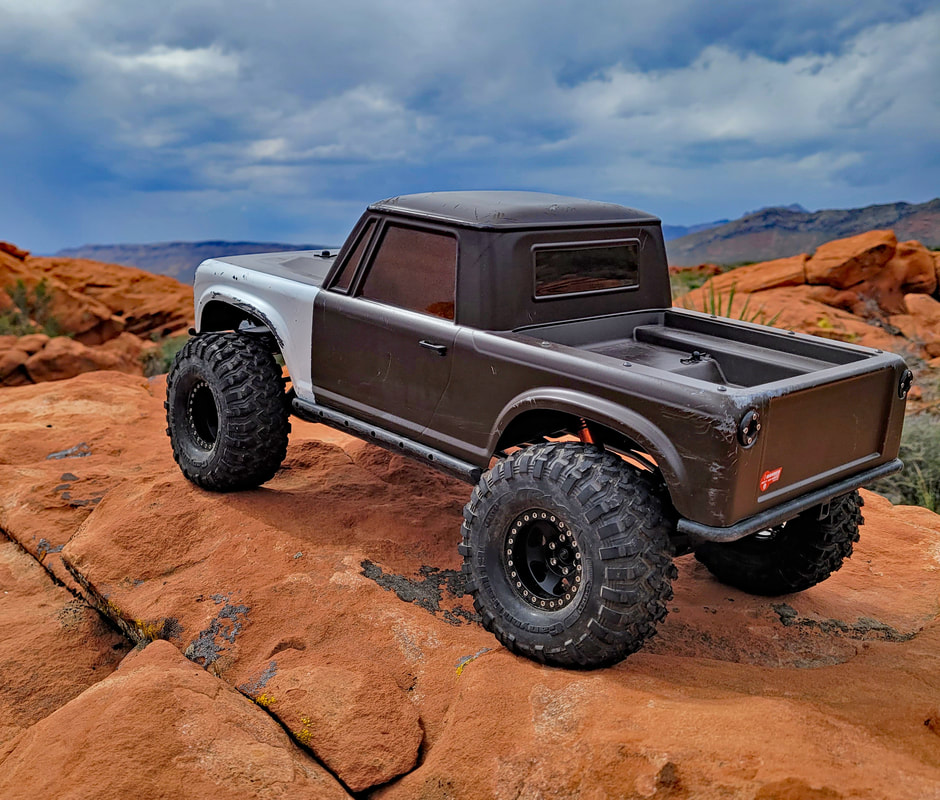Traxxas Canyon Trail 1.9" Crawling / Trail Tires
|
After completing the review on our new Traxxas TRX-4 2021 Bronco, we had been so impressed with the performance of the stock Canyon Trail tires that it only made sense to do a separate, stand-alone review focusing on the tires for this website.
During this review, the Canyon Trail setup remained the same in terms of wheels and foams, but we added in a significant amount of trail time with the Canyon Trail tires mounted on our Vanquish VS 410 Pro. While the TRX-4 Bronco is highly capable on the trail, the VS 410 takes technical rock crawling to the next level, and we wanted to see if these Canyon Trail tires could handle steeper and more difficult crawling lines. |
For this evaluation, we decided to split up testing time between Badrock Ridge and Calico Basin. While both areas are similar in terrain features, Calico Basin has a more developed system of trails and basic crawling features, whereas Badrock Ridge is more technical and rockier, and overall, much more challenging.
Testing Setup
If you haven’t read the TRX-4 review, you will have missed our process of removing the Canyon Trail tires from the factory Traxxas plastic wheels. The following text is from that review:
“We wanted to salvage the tires and see how they would perform with upgraded foams and beadlock wheels. To remove the tires, we soaked them in a sealed paint can with 2” of acetone in the bottom. In past experience, we found it’s best to elevate the tires on a small glass block so they are not submerged in the liquid acetone, allowing only the vapors to work their magic on the superglue attaching the tires to the plastic wheels. Once the tires came loose (about two days), they were washed with warm soapy water, dried, coated in a thin layer of silicone oil, and then sealed up in zip-lock bags.
After a week, we wiped off all remaining silicone, vented with three small holes ( 3mm ), and mounted the Canyon Trails with a new set of Crawler Innovations foams onto a set of Injora beadlock aluminum wheels. The rubber felt as good as new, and they looked much better on the gloss-black aluminum deep-dish wheels.”
The foams from Crawler Innovations were their Lil’ Nova foams with comp-cut inner closed-cell foam at 4.5” in diameter. The front foams used the CI soft foam outer rings, and the rears used their medium outer ring. I’m guessing we have about a dozen of these setups now, and for any crawler over 2200 grams, this feels like the ideal pairing.
While the Canyon Trail tires had already accumulated a decent amount of trail time while reviewing the TRX-4, there was still plenty of life in these tires for a full assessment.
If you haven’t read the TRX-4 review, you will have missed our process of removing the Canyon Trail tires from the factory Traxxas plastic wheels. The following text is from that review:
“We wanted to salvage the tires and see how they would perform with upgraded foams and beadlock wheels. To remove the tires, we soaked them in a sealed paint can with 2” of acetone in the bottom. In past experience, we found it’s best to elevate the tires on a small glass block so they are not submerged in the liquid acetone, allowing only the vapors to work their magic on the superglue attaching the tires to the plastic wheels. Once the tires came loose (about two days), they were washed with warm soapy water, dried, coated in a thin layer of silicone oil, and then sealed up in zip-lock bags.
After a week, we wiped off all remaining silicone, vented with three small holes ( 3mm ), and mounted the Canyon Trails with a new set of Crawler Innovations foams onto a set of Injora beadlock aluminum wheels. The rubber felt as good as new, and they looked much better on the gloss-black aluminum deep-dish wheels.”
The foams from Crawler Innovations were their Lil’ Nova foams with comp-cut inner closed-cell foam at 4.5” in diameter. The front foams used the CI soft foam outer rings, and the rears used their medium outer ring. I’m guessing we have about a dozen of these setups now, and for any crawler over 2200 grams, this feels like the ideal pairing.
While the Canyon Trail tires had already accumulated a decent amount of trail time while reviewing the TRX-4, there was still plenty of life in these tires for a full assessment.
|
Canyon Trail Details
The Traxxas Canyon Trail tires bring the curb appeal of a chunky, all terrain mud slinging tire that most of us would happily mount on our personal 1:1 off-road machine if possible. The Canyon Trails showcases a large lug pattern wrapping around the outer edge of the tire in a staggered pattern with every other lug set slightly inwards to the centerline of the tire. Stepping around the crown of the tire are smaller, staggered blocks which continue down from the outer lug pattern. These are designed to help grab hold of rock edges next to the side of the tire, all while protecting the smooth sidewall of the tire carcass. These side blocks are less pronounced than with other crawling tires, leaning a bit into their scale looks. Speaking of scale looks, the Canyon Trail tires do look like real mud and rock crawling tires. While not a specific copy of any 1:1 tire, these look a bit like a cross between the BFG mud terrain KM2’s and the Maxxis Trepadors, with some reworking of the inner lug pattern. |
|
Running down the middle of the tire is a staggered V-blocked tread pattern with a single small sipe-cut in the middle. Between the large, staggered tire lugs are smaller rock-ejector ribs which seem to be large enough to be functional and add an additional element of realism to the Canyon Trail tires.
Wrapped around the sidewall is the tire name, company name, direction of rotation, and tire dimensions. Speaking of the distinctly molded rotational direction arrows on the tire’s sidewall, even with that large arrow showing the correct way to mount the tires, we were still able to run an entire trail session without realizing they were installed backwards on both the VS-410 and TRX-4. Somehow we had mixed up the left and right sides of the wheels and tires. For a webpage obsessed with tire details, we chuckled at this oversight and remounted the tires for proper rotation. |
As a final detail, the Canyon Trails are molded from a soft rubber compound, known as "S1" in Traxxas speak. It is the softest rubber compound used in their RC lineup and appears to be ideally suited for trail running and rock crawling. There are a number of knock-off versions of this tire floating around on EBay for a few dollars less, but keep in mind they are not made from the same S1 rubber compound, and in our experience, all knock-off tires we’ve tested have performed terribly.
|
TRX-4 Testing at Calico Basin
We decided to kick off this round of testing at Calico Basin with the TRX-4 2021 Bronco, looking forward to stretching out its legs on the various trails comprised of eroded sandstone formations as well as general rock and trail debris. Switching between the high and low speed transmission setting, we made good time along the lower sections of trail as we headed into a steep and loose sandstone formation. Calico Basin sees a good mount of foot traffic from hikers and rock climbers, resulting in much more loose rock and debris around the bases of the sandstone. While not as steep or technical as Badrock Ridge, the loose material on the trail brings its own set of challenges. |
|
Moving along the lower section, the Canyon Trail tires felt well-suited to the task at hand, making short work of the rocks and washed-out sections of trail due to the recent rains.
Arriving at the base of the first large sandstone formation, we dropped into low gear and locked the front and rear differentials. Ramping up the throttle, the TRX-4 smoothly worked its way up the first section of sandstone. Halfway up the rocks, and the trail became much steeper. For more competition-oriented trucks, this steeper incline poses no real obstacle, but the somewhat top-heavy TRX-4 needed a bit more careful of route planning. |
|
Up and over a series of steps, the extra height of the portal axles came in handy, but the tires were still performing the lion’s share of the work.
A few of the rocky steps needed more than one attempt, but we continued up to the top without too much trouble. The traction remained good, showing that the CG of the TRX-4 being the real limitation as to how steep the Bronco could climb. |
|
At one point the trail was just too steep to continue up, so we hooked a left and descended into a small gully eroded into the rock. This was easier said than done, with the downward transition made more difficult due to the sloping of the rock, resulting in an off-camber descending corner.
Seeing that a tumble at this point would leave some gnarly scratches on the body, we gingerly crept down the rock while watching to see how high the rear passenger-side tire would float up off the ground. Fortunately, the Canyon Trail tires held firm in the front, guiding the nose of the Bronco down and to the left, completing the difficult turn. On the front tires, the staggered side-lugs of the Canyon Trails locked into the rocky edge without even a hint of slipping. This is where you see rubber quality and lug pattern work together for optimal performance. |
|
With a better line to the top, we ramped up the throttle and worked our way up the remaining section of sandstone. The Canyon Trail tires proved to have plenty of traction for the TRX-4’s capability on the trail, and that’s precisely what we were hoping for.
We spent the next few hours attempting different trails, all with varying steepness and difficulty. Calico Basin is an ideal trail system for the TRX-4, and while we were challenged more than a few times, the TRX-4 performed quite well. The two-stage foams allowed the outside of the tires to conform to the rock’s surface while the close-cell inner foams supported the crawler’s weight. |
|
Badrock Ridge with the VS 410 Pro
With the TRX-4 complete with its role in the tire evaluation, we removed the wheels and tires and mounted them up to the VS 410. Starting out one sunny morning at Badrock, we were anxious to get the VS 410 up and running to see what we could scale with these Canyon Trails. The weather was finally cooperating with mild 80-degree temps, and the recent rainstorms had washed away most of the loose rock and sand from our crawling areas. Swinging around the lower east section of Badrock, we headed up a few steep sections of trail which contained a mix of smooth, freshly exposed sandstone along with some older and much more eroded sections of sandstone near the top. |
|
Heading straight up the smooth sandstone, the S1 rubber compound demonstrated a superb level of traction, sticking to the rock’s surface while the VS 410 easily ascended the rock face. Nearing the top, the front tires were able to grab hold of the wavy shapes in the sandstone, allowing the truck to move slightly over to the right and up to the top of the trail.
Working our way further to the east, we had to carefully creep along a steep sidehill section of the trail which serves as the only access route to the upper section of trail. The sidehill is steep enough that most crawlers find themselves too top-heavy to make the route, often toppling over and bouncing their way down to the bottom of the formation. During the TRX-4 review, we were unable to clear this section of trail for the same reasons. |
|
Settling down into a smooth brushed-motor crawl, the VS 410 carefully worked its way around the side of the trail, starting low and angling the front of the truck up as we rounded the steepest section of the sidehill.
The driver’s side tires were just skimming the rock’s surface while the passenger tires were jammed hard into the rock, using up about a quarter of the sidewall in flex. Slow and steady was the pace, and within a few minutes time, we were past the sidehill and making the turn up to the top of the trail. Seeing that the VS 410 was just about at its limits on the sidehill angle, the Canyon Trail tires held up their end of the bargain with superb traction and control. |
This is a good balance of crawler capability and tire performance, and I feel the Canyon Trail tires can be pushed a bit further with the VS 410 than what the TRX-4 is capable of handling.
We spent a few more hours that day on the trail as well as a few subsequent outings with the VS 410, looking to learn more about the Canyon Trail tires as to what they can and cannot handle. Not surprisingly, these tires we well suited to just about any terrain at Badrock Ridge and proved to be an ideal match to the VS 410’s abilities.
We spent a few more hours that day on the trail as well as a few subsequent outings with the VS 410, looking to learn more about the Canyon Trail tires as to what they can and cannot handle. Not surprisingly, these tires we well suited to just about any terrain at Badrock Ridge and proved to be an ideal match to the VS 410’s abilities.
|
Highline Trail
It was late Sunday morning, and we had wrapped up the text for this review, but we still needed to shoot a few more photos to round out the article. Heading out with a single 450 mAh battery and the camera, we hadn’t anticipated spending much time on the trail. After snapping a few photos of the VS 410 scaling some difficult lines, we realized that Highline Trail was just one rock pile over from our right shoulder. Highline trail is a tall, wickedly narrow right-leaning rock spine consisting of fractured blocks of sandstone rising as high as 20’ off the desert floor. It’s hard enough to hike around the edges, let alone running a crawler to the top. We’ve made the ascent with a handful of crawlers, but most have either been 2.2” rigs or Class 3 portal trucks running 1.9” competition tires. |
As good as the VS 410 is set up for technical climbing, the straight-axle and 4.6” tall Canyon Trail tires were going to make this a very difficult proposition. That said, we still had plenty of battery life for an attempt, so with the camera ready to capture the success or failure, we gave it a shot.
|
Starting up from the bottom, we decided to take the left side of the first elevation.
Our thought was to gamble on the steep sidehill running along the left side of the trail in hopes that the steep angle would not overpower the Canyon Trail tires, allowing us to work up and over the lower center section. This route skips a sheer wall pockmarked with eroded holes and deep undercuts, wrapping around the right side of the trail. The left and right sides of the trail meet in a shallow saddle on the other side of this lower rock section, setting the driver up for a treacherous ascent to the top. The VS 410 scraped and clawed to get things moving, but without too much effort we were up and running, making quick time along the left side of the rock spine, carefully working around smaller outcroppings. The Canyon Trail tires were giving their all, leaving small bits of rubber on the rock edges. |
|
One could argue that it’s smooth sailing along the left side of the trail, and it’s a fair assessment until you reach the next rock face. This sets you up to navigate a ridiculously steep fracture in the rock, all while climbing up and to the right.
At this point things got hairy pretty quick, and we had to really focus our attention on the next few turns. Mistakes at this point on the trail will have you falling off the 40 degree angle sloping down to the right, 10' off the floor of a narrow canyon hacked into the rock below. The up-side is that photos are fairly easy to take because most shots are at eye-level or just a few feet above. No more crouching over on the trail. |
|
As you begin to make the right turn, the first thing which grabs your attention is the moment your driver’s right rear tire falls off the edge and hangs in free space for the next few moments.
If your front driver's side tire is not not planted, your truck will follow that rear left tire and pull the whole rig down to the left for a nasty tumble to the bottom. There is no way around this turn; you have to be able to carry / balance the rear left tire in space until you complete the turn and align the front end of the truck square with the rock's surface. We approached this maneuver slowly, and while there was a moment where we had two tires suspended in mid air, the other two Canyon Trails were able to stick to the rock and allow us to complete the turn to the right and get the front passenger tire into contact with the rock. |
Truck layout and balance play a big role here as well, and our VS 410 is pretty well dialed in for this kind of crawling. Suspension geometry, weight distribution, and CG with either work for you or against you in these situations. Fortunately for us, Vanquish did a great job with the VS 410 Pro design, so all we had to do were some minor adjustment to handle this type of terrain.
|
This section is hard enough with a 2.2” or 1.9” with portals, so this straight-axle VS 410 was working overtime to keep things under control.
The noises from the Canyon Trail tires were startling at times, but they absolutely refused to give up their hold, so for the time being the truck was still upright. Here's the good news; we still had to get up and over this rock face. If you look close at the photo, you'll see that the rear tires will drop down and touch the sloped face before we hook the center line of the front axle over the top edge. That's not ideal. That said, the experienced eye will spot the sharp edges of rock eroded away, slight to the right of the passenger's front tire. Our plan was to aim for that spot and hope traction will hold up long enough for to hook a few tire lugs around that rock edge. |
|
Slowly ramping up the throttle, the VS 410 nosed down into the rock and began to climb the uneven rock face, carefully creeping to the right side of the block.
A moment later, we had the front tires over the top edge and just needed the rear tires to follow along, maintaining traction so we didn’t go sliding down off to the right. Keep in mind that we still had a few more tricky spots to go. At this point I was ready to sign off on any remaining questions about the Canyon Trail's performance; I had truly doubted we would have made it this far on Highline Trail, and the tire's performance had well exceeded my expectations. |
|
Now that we find ourselves on the steep right-side of the rock spine, we now had to keep the nose of the truck oriented up to the left side of the trail.
This kept the front tires planted and used the long axis of the wheel base to keep the rear tires dug into the slick sandstone. Throughout this review you've seen me mention rubber compound a few times, and how these tires use the S1 compound from Traxxas, and on trails like this it really matters. In the accompanied photo, the S1 compound prevents the front driver's side tire from slipping down to the right on the smooth sandstone. If you look close, you can see the front driver's side tire being pulled away from the wheel while it fights to maintain traction. This is all rubber compound quality at work here, and the S1 is proving its worth. |
|
One more final up-and-over, and we arrived at the summit of Highline Trail.
We couldn't have been more pleased with the VS 410's performance on this trail, and the Traxxas Canyon Trail tires played a big role in the success of this climb. Ten minutes later, the sky opened up and rain came thundering down from above. We quickly packed it up and headed back to town. As an afterthought to snap a few extra photos for the review, I feel this trail session was by far the most important, productive, and educational part of our experience with the Canyon Trail tires. We knew these tires were good from our first experience with the TRX-4 Bronco, but this level of performance on the VS 410 was something entirely unexpected. |
|
Conclusion
The Traxxas Canyon Trails are one of the best crawling tires we have tested to date. The S1 rubber quality is excellent, providing a high level of traction on steep rock surfaces. This rubber quality compliments the tire’s construction and tread pattern, making the Canyon Trail ideal for just about any off-road terrain. As with most crawling tires, it’s best to pair these tires with a set of quality two-stage foams to really make them shine. We have yet to find a tire which didn’t improve with two-stage foams, and the Canyon Trail tires proved to be no different. |
From our perspective, the tedious effort to remove the tires from the factory plastic wheels paid off, but luckily for everyone else, you can purchase the Canyon Trail tires unmounted from Traxxas. Just be sure to order the right sizing; they have this tire for the 2.2” wheel as well as the 1.9” wheel. We’ve listed the correct part number below for the 1.9” wheel.
Considering the sharp looks, excellent rubber quality, and solid crawling performance, the pricing at $24.00 per pair makes the Canyon Trail tires very much worth considering. The only thing you need to be careful of is not to purchase a knock-off version which tend to use a much lower quality rubber. Be sure to buy from a trustworthy dealer ( i.e., not ebay ) or directly from Traxxas.
Considering the sharp looks, excellent rubber quality, and solid crawling performance, the pricing at $24.00 per pair makes the Canyon Trail tires very much worth considering. The only thing you need to be careful of is not to purchase a knock-off version which tend to use a much lower quality rubber. Be sure to buy from a trustworthy dealer ( i.e., not ebay ) or directly from Traxxas.
Evaluation Results
Technical Rock: 28/30
Large Slab ( Slick Rock ): 19/20
Tire Construction Quality and Appearance: 19/20
Rubber Compound: 18/20
Tread Life: 5/5
Versatility: 4/5
Total Score: 93/100
Technical Rock: 28/30
- Scoring the Canyon Trail tire from Traxxas wasn’t something we took lightly. After reviewing our notes and talking over their stunning performance on Highline Trail, the score of 28 made the most sense; and that’s highly unexpected from an OEM tire from any manufacturer. The Canyon Trail is a fantastic tire on technical rock, but it favors a heavier crawler, making it spot-on for their TRX-4 platforms.
Large Slab ( Slick Rock ): 19/20
- As with the Technical Rock score, the Canyon Trail tires are surprisingly capable on the steep, slick rock slabs. I still marvel at some of the steep lines these tires knocked out. Much of this is due to the Traxxas S1 soft rubber compound, but also due to the unique tread pattern which is open enough to drive the lug wedges into the rocks face, with the truck’s weight forcing them to hold tight.
Tire Construction Quality and Appearance: 19/20
- Canyon Trail tires are exceptionally well built with every detail we concern ourselves with properly addressed. Perfect beads, correct carcass thickness, and a lovely tread pattern design; we could find not a single error in any of the tires, and that’s after we had to pull them from the OEM plastic wheels. That said, they are a thicker, more robust tire that’s probably going to be a bit less flexible for trucks with a running weight under 2500 grams.
Rubber Compound: 18/20
- The S1 compound is a soft, flexible rubber compound. It’s not as sticky as other rubber types, but it feels right when mounted on our TRX-4 2021 Bronco. It has a high-quality feel to the rubber material along with the right amount of flex to allow the carcass to wrap around rocks.
Tread Life: 5/5
- Tough, durable, with just a bit of wear starting to show on the edges of the outer lugs.
Versatility: 4/5
- This is one of those tires which you could use it for just about any type of trail driving or serious crawling. As mentioned before, for light-weight crawlers, you might struggle to have enough flexibility in the front tires on steep lines, but that’s about the only limitation we can find with the Canyon Trail tires.
Total Score: 93/100
Specs
Traxxas Canyon Trail 1.9" Crawler / Trail Tire
Traxxas Canyon Trail 1.9" Crawler / Trail Tire
- Part Number: 8270
- Retail Price: $24.00 per pair
- Size: 116mm / 4.6”
- Rubber Compound: S1 “Soft”
- Directional: Yes..!
- Test Trucks: Vanquish VS 410 Pro, Traxxas TRX-4 2021 Bronco
- Foams Used: Crawler Innovations Lil’ Nova 4.5” comp-cut soft front, 4.5” comp-cut medium rear.
